Lists of birds of Canada and the United States


This list of North American birds is a comprehensive listing of all the bird species known from the North American continent north of Mexico.
Scope of this list
North American birds most closely resemble those of Eurasia, which was connected to the continent as part of the supercontinent Laurasia until recent times. Many groups occur throughout the northern hemisphere and worldwide. However some groups unique to the New World have also arisen including the hummingbirds, the New World vultures, the New World quail, the tyrant flycatchers, the vireos, the mimids, the New World warblers, the tanagers, the cardinals and the icterids.
Several common birds in North America, such as the House Sparrow, the Rock Dove, the European Starling, and the Mute Swan are introduced species, meaning that they are not native to this continent but were brought here by man from Europe or elsewhere. Introduced species are marked on this list as (I). There may be species that have individual escapees or small feral populations in North America that are not on this list. This is especially true of birds that are commonly held as pets, such as parrots and finches.
One species, the Cattle Egret, was historically an African bird. In the 20th century this bird colonized North America and is now found throughout the lower 48 states of the U.S.. The Cattle Egret is the only Old World bird to establish itself in North America in historical times without being introduced by man. As such, it is not marked as introduced on this list.
The definition of the area covered by a list of "North American birds" is somewhat subjective. This list is based on a checklist used by the American Birding Association (ABA), the list used by most field guides for North American birds.
The original list published by the American Ornithologists' Union (AOU) in 1886 covered birds found in North America north of Mexico, and included Baja California, Bermuda and Greenland. In 1983, the area was expanded to included all of Mexico, Central America south through Panama, the West Indies and the Hawaiian Islands, while Greenland was dropped. This expansion more than doubled the number of birds on the AOU list. Other organizations, such as the ABA, use a smaller area: the current ABA area includes the 49 continental states of the US, Canada, and the French islands of St. Pierre and Miquelon, plus surrounding waters. It does not include Greenland, Bermuda, the Bahamas or the Hawaiian Islands. Since the ABA follows the AOU on taxonomical matters, the AOU's list is used to settle questions of taxonomy.
Taxonomy
The taxonomic treatment (designation and sequence of orders, families, and species) and nomenclature (common and scientific names) used in the accompanying bird lists adhere to the conventions of the AOU's (1998) Check-list of North American birds, the recognized scientific authority on the taxonomy and nomenclature of North America birds. The AOU's Committee on Classification and Nomenclature, the body responsible for maintaining and updating the Check-list, "strongly and unanimously continues to endorse the biological species concept (BSC), in which species are considered to be genetically cohesive groups of populations that are reproductively isolated from other such groups" (AOU 1998). See Sibley-Ahlquist taxonomy for an alternative phylogenetic arrangement based on DNA-DNA hybridization.
Unless otherwise noted, all species listed below are considered to occur regularly in North America as permanent residents, summer or winter residents or visitors, or migrants. The following codes are used to denote certain categories of species:
- (A) = Accidental occurrence based on one or two (rarely more) records, and unlikely to occur regularly.
- (C) = Casual occurrence based on two or a few records, with subsequent records not improbable.
- (E) = Extinct; a recent member of the avifauna that no longer exists.
- (Ex) = Extirpated; no longer occurs in area of interest, but other populations still exist elsewhere.
- (I) = Introduced population established solely as result of direct or indirect human intervention; synonymous with non-native and non-indigenous.
Ducks, Geese, and Swans
Order: Anseriformes Family: Anatidae
The family Anatidae includes the ducks and most duck-like waterfowl, such as geese and swan. These are birds that are modified for an aquatic existence with webbed feet, bills which are flattened to a greater or lesser extent, and feathers that are excellent at shedding water due to special oils. There are 131 species world wide and 61 North American species.

- Black-bellied Whistling-Duck, Dendrocygna autumnalis
- Fulvous Whistling-Duck, Dendrocygna bicolor
- Bean Goose, Anser fabalis
- Pink-footed Goose, Anser brachyrhynchus (A)
- Greater White-fronted Goose, Anser albifrons
- Lesser White-fronted Goose, Anser erythropus (A)
- Emperor Goose, Chen canagica
- Snow Goose, Chen caerulescens
- Ross's Goose, Chen rossii
- Cackling Goose, Branta hutchinsii
- Canada Goose, Branta canadensis
- Brant, Branta bernicla
- Barnacle Goose, Branta leucopsis (C)
- Mute Swan, Cygnus olor (I)
- Trumpeter Swan, Cygnus buccinator
- Tundra Swan, Cygnus columbianus
- Whooper Swan, Cygnus cygnus
- Muscovy Duck, Cairina moschata

Wood Duck pair. - Wood Duck, Aix sponsa
- Gadwall, Anas strepera
- Falcated Duck, Anas falcata (C)
- Eurasian Wigeon, Anas penelope
- American Wigeon, Anas americana
- American Black Duck, Anas rubripes
- Mallard, Anas platyrhynchos
- Mottled Duck, Anas fulvigula
- Spot-billed Duck, Anas poecilorhyncha (C)
- Blue-winged Teal, Anas discors
- Cinnamon Teal, Anas cyanoptera
- Northern Shoveler, Anas clypeata
- White-cheeked Pintail, Anas bahamensis
- Northern Pintail, Anas acuta
- Garganey, Anas querquedula
- Baikal Teal, Anas formosa (C)
- Green-winged Teal, Anas crecca
- Canvasback, Aythya valisineria
- Redhead, Aythya americana
- Common Pochard, Aythya ferina
- Ring-necked Duck, Aythya collaris
- Tufted Duck, Aythya fuligula
- Greater Scaup, Aythya marila
- Lesser Scaup, Aythya affinis
- Steller's Eider, Polysticta stelleri
- Spectacled Eider, Somateria fischeri
- King Eider, Somateria spectabilis
- Common Eider, Somateria mollissima
- Harlequin Duck, Histrionicus histrionicus
- Labrador Duck, Camptorhynchus labradorius (E)
- Surf Scoter, Melanitta perspicillata
- White-winged Scoter, Melanitta fusca
- Black Scoter, Melanitta nigra
- Long-tailed Duck, Clangula hyemalis
- Bufflehead, Bucephala albeola
- Common Goldeneye, Bucephala clangula
- Barrow's Goldeneye, Bucephala islandica
- Smew, Mergellus albellus
- Hooded Merganser, Lophodytes cucullatus
- Common Merganser, Mergus merganser
- Red-breasted Merganser, Mergus serrator
- Masked Duck, Nomonyx dominicus
- Ruddy Duck, Oxyura jamaicensis
Curassows and Guans
Order: Galliformes Family: Cracidae
The chachalacas, guans and curassows are birds in the family Cracidae. These are large birds, similar in general appearance to turkeys. The guans and curassows live in trees, but the smaller chachalacas are found in more open scrubby habitats. They are generally dull-plumaged, but the curassows and some guans have colourful facial ornaments. There are 50 species world-wide, all of which arw found only in the Americas, and 1 North American species.
- Plain Chachalaca, Ortalis vetula
Partridges, Grouse, Turkeys, and Old World Quail
Order: Galliformes Family: Phasianidae
The Phasianidae is a family of birds which consists of the pheasants and their allies. These are terrestrial species, variable in size but generally plump, with broad relatively short wings. Many species are gamebirds, or have been domesticated as a food source for humans. There are 180 species world wide and 16 North American species.

- Chukar, Alectoris chukar (I)
- Himalayan Snowcock, Tetraogallus himalayensis (I)
- Gray Partridge, Perdix perdix (I)
- Ring-necked Pheasant, Phasianus colchicus (I)
- Ruffed Grouse, Bonasa umbellus
- Greater Sage-Grouse, Centrocercus urophasianus
- Gunnison Sage-Grouse, Centrocercus minimus
- Spruce Grouse, Falcipennis canadensis
- Willow Ptarmigan, Lagopus lagopus
- Rock Ptarmigan, Lagopus mutus
- White-tailed Ptarmigan, Lagopus leucurus
- Blue Grouse, Dendragapus obscurus
- Sharp-tailed Grouse, Tympanuchus phasianellus
- Greater Prairie-Chicken, Tympanuchus cupido
- Lesser Prairie-Chicken, Tympanuchus pallidicinctus
- Wild Turkey, Meleagris gallopavo
New World Quail
Order: Galliformes Family: Odontophoridae
The New World quails are small, plump terrestrial birds only distantly related to the quails of the Old World, but named for their similar appearance and habits. There are 32 species, world-wide, all found only in the Americas and 6 North American species.
- Mountain Quail, Oreortyx pictus
- Scaled Quail, Callipepla squamata
- California Quail, Callipepla californica
- Gambel's Quail, Callipepla gambelii
- Northern Bobwhite, Colinus virginianus
- Montezuma Quail, Cyrtonyx montezumae
Loons
Order: Gaviiformes Family: Gaviidae
Loons are aquatic birds size of a large duck, to which they are unrelated. Their plumage is largely grey or black, they have spear-shaped bills. Loons swim well, and fly adequately, but, because their legs are placed towards the rear of the body, are almost hopeless on land. There are 5 species world-wide and 5 North American species.
- Red-throated Loon, Gavia stellata.
- Arctic Loon, Gavia arctica .
- Pacific Loon, Gavia pacifica
- Common Loon, Gavia immer .
- Yellow-billed Loon, Gavia adamsii .
Grebes

Order: Podicipediformes Family: Podicipedidae
Grebes small to medium-large sized freshwater diving birds. They have lobed toes, and are excellent swimmers and divers. However, they have their feet placed far back on the body, making them quite ungainly on land. There are 20 species world-wide and 7 North American species.
- Least Grebe, Tachybaptus dominicus
- Pied-billed Grebe, Podilymbus podiceps
- Horned Grebe, Podiceps auritus
- Red-necked Grebe, Podiceps grisegena
- Eared Grebe, Podiceps nigricollis
- Western Grebe, Aechmorphorus occidentalis
- Clark's Grebe, Aechmorphorus clarkii
Albatrosses
Order: Procellariiformes Family: Diomedeidae
The albatrosses are amongst the largest of flying birds, and the great albatrosses from the genus Diomedea have the largest wingspans of any extant birds. There are 21 species world wide and 8 North American species.
- Yellow-nosed Albatross, Thalassarche chlororhynchos (A)
- Shy Albatross, Thalassarche cauta (A)
- Black-browed Albatross, Thalassarche melanophris (A)
- Wandering Albatross, Diomedea exulans (A)
- Laysan Albatross, Phoebastria immutabilis
- Black-footed Albatross, Phoebastria nigripes
- Short-tailed Albatross, Phoebastria albatrus (A)
Shearwaters and Petrels
Order: Procellariiformes Family: Procellariidae
The procellariids are the main group of medium-sized 'true petrels', characterised by united nostrils with medium septum, and a long outer functional primary. There are 75 species world wide and 24 North American species..
- Northern Fulmar, Fulmarus glacialis
- Great-winged Petrel, Pterodroma macroptera (A)
- Herald Petrel, Pterodroma arminjoniana (C or A)
- Murphy's Petrel, Pterodroma ultima
- Mottled Petrel, Pterodroma inexpectata
- Bermuda Petrel, Pterodroma cahow
- Black-capped Petrel, Pterodroma hasitata
- "Dark-rumped" Petrel Pterodroma phaeopygia/sandwichensis complex
- Fea's/Zino's Petrel Pterodroma feae/madeira complex
- Cook's Petrel, Pterodroma cookii
- Stejneger's Petrel, Pterodroma longirostris (A)
- Bulwer's Petrel, Bulweria bulwerii
- Streaked Shearwater, Calonectris leucomelas (C)
- Cory's Shearwater, Calonectris diomedea
- Cape Verde Shearwater, Calonectris edwardsii (A)
- Pink-footed Shearwater, Puffinus creatopus
- Flesh-footed Shearwater, Puffinus carneipes
- Greater Shearwater, Puffinus gravis
- Wedge-tailed Shearwater, Puffinus pacificus
- Buller's Shearwater, Puffinus bulleri
- Sooty Shearwater, Puffinus griseus
- Short-tailed Shearwater, Puffinus tenuirostris
- Manx Shearwater, Puffinus puffinus
- Black-vented Shearwater, Puffinus opisthomelas
- Audubon's Shearwater, Puffinus lherminieri
- Little Shearwater, Puffinus assimilis (A)
Storm-Petrels
Order: Procellariiformes Family: Hydrobatidae
The storm-petrels are the smallest of seabirds, relatives of the petrels, feeding on planktonic crustaceans and small fish picked from the surface, typically while hovering. The flight is fluttering and sometimes bat-like. There are 21 species world wide and 10 North American species.
- Wilson’s Storm-Petrel, Oceanites oceanicus
- White-faced Storm-Petrel, Pelagodroma marina (C)
- Black-bellied Storm-Petrel, Fregetta tropica(A)
- European Storm-Petrel, Hydrobates pelagicus (A)
- Fork-tailed Storm-Petrel, Oceanodroma furcata
- Leach’s Storm-Petrel, Oceanodroma leucorhoa
- Ashy Storm-Petrel, Oceanodroma homochroa
- Band-rumped Storm-Petrel, Oceanodroma castro
- Wedge-rumped Storm-Petrel, Oceanodroma tethys
- Black Storm-Petrel, Oceanodroma melania
- Least Storm-Petrel, Oceanodroma microsoma
Tropicbirds
Order: Pelecaniformes Family: Phaethontidae
Tropicbirds are slender white birds of tropical oceans, with exceptionally long central tail feathers. Their long wings have black markings, as does the head. There are 3 species world wide and 3 North American species
- White-tailed Tropicbird, Phaethon lepturus
- Red-billed Tropicbird, Phaethon aethereus
- Red-tailed Tropicbird, Phaethon rubricauda
Boobies and Gannets
Order: Pelecaniformes Family: Sulidae
The sulids comprise the gannets and boobies. Both groups are medium-large coastal seabirds that plunge-dive for fish.There are 8 species world wide and 5 North American species.
- Masked Booby, Sula dactylatra
- Blue-footed Booby, Sula nebouxii
- Brown Booby, Sula leucogaster
- Red-footed Booby, Sula sula
- Northern Gannet, Morus bassanus
Pelicans
Order: Pelecaniformes Family: Pelecanidae
Pelicans are very large water birds with a distinctive pouch under the beak Like other birds in the order Pelecaniformes, they have four webbed toes. There are 8 species world wide and 2 North American species.
- American White Pelican, Pelecanus erythrorhynchos
- Brown Pelican, Pelecanus occidentalis
Cormorants
Order: Pelecaniformes Family: Phalacrocoracidae
Pelicans are very large water birds with a distinctive pouch under the beak Like other birds in the order Pelecaniformes, they have four webbed toes. There are 8 species world wide and 2 North American species.
- Brandt's Cormorant, Phalacrocorax penicillatus
- Neotropic Cormorant, Phalacrocorax brasilianus
- Double-crested Cormorant, Phalacrocorax auritus
- Great Cormorant, Phalacrocorax carbo
- Red-faced Cormorant, Phalacrocorax urile
- Pelagic Cormorant, Phalacrocorax pelagicus
Darters
Order: Pelecaniformes Family: Anhingidae
Pelicans are very large water birds with a distinctive pouch under the beak Like other birds in the order Pelecaniformes, they have four webbed toes. There are 8 species world wide and 2 North American species.
- Anhinga, Anhinga anhinga
Frigatebirds
Order: Pelecaniformes Family: Fregatidae
Frigatebirds are large sea-birds usually found over tropical oceans. They are large, black or black and white, with long wings and deeply-forked tails. The males have inflatable coloured throat pouches. They do not swim or walk, and cannot take off from a flat surface. Having the largest wingspan to body weight ratio of any bird, they are essentially aerial, able to stay aloft for more than a week. There are five species world-wide and three North American species.
- Magnificent Frigatebird, Fregata magnificens
- Great Frigatebird, Fregata minor
- Lesser Frigatebird, Fregata ariel (A)
Bitterns, Herons, and Egrets
Order: Ciconiiformes Family: Ardeidae
The family Ardeidae contains the herons, egrets, and bitterns. Herons and Egrets are medium to large sized wadng birds with long necks and legs. Bitterns tend to be shorter necked and more secrative. Unlike other long necked birds suck as storks, ibises and spoonbills, members of Ardeidae fly with their necks retracted. There are 61 species world wide and 17 North American species.
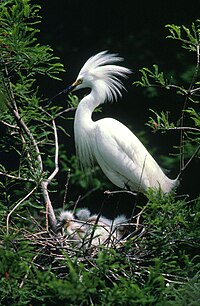
- American Bittern, Botaurus lentiginosus
- Yellow Bittern, Ixobrychus sinensis (A)
- Least Bittern, Ixobrychus exilis
- Great Blue Heron, Ardea herodias
- Great Egret, Ardea alba
- Chinese Egret, Egretta eulophotes (A)
- Little Egret, Egretta garzetta (A)
- Western Reef-Heron, Egretta gularis (A)
- Snowy Egret, Egretta thula
- Little Blue Heron, Egretta caerulea
- Tricolored Heron, Egretta tricolor
- Reddish Egret, Egretta rufescens
- Cattle Egret, Bubulcus ibis
- Chinese Pond-Heron, Ardeola bacchus (A)
- Green Heron, Butorides virescens
- Black-crowned Night-Heron, Nycticorax nycticorax
- Yellow-crowned Night-Heron, Nyctanassa violacea
Ibises and Spoonbills
Order: Ciconiiformes Family: Threskiornithidae
The family Ardeidae contains the herons, egrets, and bitterns. Herons and Egrets are medium to large sized wadng birds with long necks and legs. Bitterns tend to be shorter necked and more secrative. Unlike other long necked birds suck as storks, ibises and spoonbills, members of Ardeidae fly with their necks retracted. There are 61 species world wide and 17 North American species.
- American White Ibis, Eudocimus albus
- Scarlet Ibis, Eudocimus ruber (A)
- Glossy Ibis, Plegadis falcinellus
- White-faced Ibis, Plegadis chihi
- Roseate Spoonbill, Ajaia ajaja

Storks
Order: Ciconiiformes Family: Ciconiidae
Storks are large, heavy, long-legged, long-necked wading birds with long stout bills and wide wingspans. They lack the powder down that other wading birds such as herons, spoonbills and ibises use to clean off fish slime. Storks lack a pharynx and are mute. There are 19 species world wide and 2 North American species.
- Jabiru, Jabiru mycteria (C)
- Wood Stork, Mycteria americana
New World Vultures
Order: Ciconiiformes Family: Cathartidae
The New World vultures are not closely related to Old World vultures, but superficially resemble them because of convergent evolution. Like the Old World vultures, they are scavengers However, unlike Old World vultures, which find carcasses by sight, New World vultures have an good sense of smell with which they located carcasses. There are 7 species world wide, all found only in the Americas and 3 North American species.
- Black Vulture, Coragyps atratus
- Turkey Vulture, Cathartes aura
- California Condor, Gymnogyps californianus
Flamingos
Order: Phoenicopteriformes Family: Phoenicopteridae
Flamingos (genus Phoenicopterus monotypic in family Phoenicopteridae) are gregarious wading birds, usually 3–5 feet in height, found in both the Western and Eastern Hemispheres. They are more numerous in the latter. Flamingos filter-feed on shellfish and algae. Their oddly-shaped beaks are specially adapted to separate mud and silt from the food they consume, and are uniquely used upside-down. There are 6 species world wide and 1 North American species.
- Greater Flamingo, Phoenicopterus ruber
Hawks, Kites, and Eagles
Order: Falconiformes Family: Accipitridae
The family Accipitridae is a family of birds of prey and include hawks, eagles, kites, harriers and Old World vultures. These birds have very large powerful hooked beaks for tearing flesh from their prey, strong legs, powerful talons, and keen eyesight. There are 233 species world wide and 28 North American species.
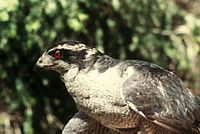
- Osprey, Pandion haliaetus
- Hook-billed Kite, Chondrohierax uncinatus
- Swallow-tailed Kite, Elanoides forficatus
- White-tailed Kite, Elanus leucurus
- Snail Kite, Rostrhamus sociabilis
- Mississippi Kite, Ictinia mississippiensis
- Bald Eagle, Haliaeetus leucocephalus
- White-tailed Eagle, Haliaeetus albicilla (C)
- Steller's Sea-Eagle, Haliaeetus pelagicus (C or A)
- Northern Harrier, Circus cyaneus
- Sharp-shinned Hawk, Accipiter striatus
- Cooper's Hawk, Accipiter cooperii
- Northern Goshawk, Accipiter gentilis
- Crane Hawk, Geranospiza caerulescens (A)
- Gray Hawk, Asturina nitida
- Common Black-Hawk, Buteogallus anthracinus
- Harris's Hawk, Parabuteo unicinctus
- Roadside Hawk, Buteo magnirostris (C)
- Red-shouldered Hawk, Buteo lineatus
- Broad-winged Hawk, Buteo platypterus
- Short-tailed Hawk, Buteo brachyurus
- Swainson's Hawk, Buteo swainsoni
- White-tailed Hawk, Buteo albicaudatus
- Zone-tailed Hawk, Buteo albonotatus
- Red-tailed Hawk, Buteo jamaicensis
- Ferruginous Hawk, Buteo regalis
- Rough-legged Hawk, Buteo lagopus
- Golden Eagle, Aquila chrysaetos
Caracaras and Falcons
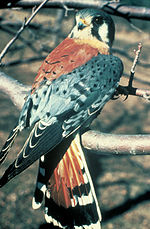
Order: Falconiformes Family: Falconidae
Falconidae is a family of diurnal birds of prey, notably the falcons and caracaras. They differ from hawks, eagles, and kites in that they kill with their beaks instead of their feet. There are 62 species world wide and 10 North American species.
- Collared Forest-Falcon, Micrastur semitorquatus (A)
- Crested Caracara, Caracara cheriway
- Eurasian Kestrel, Falco tinnunculus (C)
- American Kestrel, Falco sparverius
- Merlin, Falco columbarius
- Eurasian Hobby, Falco subbuteo (C)
- Aplomado Falcon, Falco femoralis
- Gyrfalcon, Falco rusticolus
- Peregrine Falcon, Falco peregrinus
- Prairie Falcon, Falco mexicanus
Rails, Gallinules, and Coots
Order: Gruiformes Family: Rallidae
Rallidae is a large family of small to medium-sized birds which includes the rails, crakes, coots, and gallinules. The most typical family members occupy dense vegetation in damp environments near lakes, swamps, or rivers. In general they are shy and secretive birds, difficult to observe. Most species have strong legs, and have long toes which are well adapted to soft, uneven surfaces. They tend to have short, rounded wings and be weak fliers. There are 143 species world wide and 13 North American species.

- Yellow Rail, Coturnicops noveboracensis
- Black Rail, Laterallus jamaicensis
- Corn Crake, Crex crex (C)
- Clapper Rail, Rallus longirostris
- King Rail, Rallus elegans
- Virginia Rail, Rallus limicola
- Sora, Porzana carolina
- Paint-billed Crake, Neocrex erythrops (A)
- Spotted Rail, Pardirallus maculatus (A)
- Purple Gallinule, Porphyrio martinica
- Common Moorhen, Gallinula chloropus
- Eurasian Coot, Fulica atra (C or A)
- American Coot, Fulica americana
Limpkins
The Limpkin is an odd bird that looks like a large rail, but is skeletally closer to the cranes. It is found in marshes with some trees or scrub in the Caribbean, South America and southern Florida. There is 1 species world wide, 1 North American species.
Order: Gruiformes Family: Aramidae
- Limpkin, Aramus guarauna
Cranes
Cranes are large, long-legged and long-necked birds. Unlike the similar-looking but unrelated herons, cranes fly with necks outstretched, not pulled back. Most have elaborate and noisy courting displays or "dances". There are 15 species worldwide, 3 North American species.
Order: Gruiformes Family: Gruidae
- Sandhill Crane, Grus canadensis
- Common Crane, Grus grus (A)
- Whooping Crane, Grus americana
Thick-knees
Order: Charadriiformes Family: Burhinidae
The thick-knees are a group of largely tropical waders in the family Burhinidae. They are found worldwide within the tropical zone, with some species also breeding in temperate Europe and Australia. They are medium to large waders with strong black or yellow black bills, large yellow eyes and cryptic plumage. Despite being classed as waders, most species have a preference for arid or semi-arid habitats.
- Double-striped Thick-knee, Burhinus bistriatus (A)
Lapwings and Plovers
The family Charadriidae includes the plovers, dotterels, and lapwings. They are small to medium-sized birds with compact bodies, short, thick necks and long, usually pointed, wings. They are found in open country worldwide, mostly in habitats near water, although there are some exceptions. There are 66 species world-wide, 17 North American species
Order: Charadriiformes Family: Charadriidae

- Northern Lapwing, Vanellus vanellus (C)
- Black-bellied Plover, Pluvialis squatarola
- European Golden-Plover, Pluvialis apricaria (C)
- American Golden-Plover, Pluvialis dominica
- Pacific Golden-Plover, Pluvialis fulva
- Lesser Sand-Plover, Charadrius mongolus
- Greater Sand-Plover, Charadrius leschenaultii
- Collared Plover, Charadrius collaris (A)
- Snowy Plover, Charadrius alexandrinus
- Wilson's Plover, Charadrius wilsonia
- Common Ringed Plover, Charadrius hiaticula (C)
- Semipalmated Plover, Charadrius semipalmatus
- Piping Plover, Charadrius melodus
- Little Ringed Plover, Charadrius dubius (C)
- Killdeer, Charadrius vociferus
- Mountain Plover, Charadrius montanus
- Eurasian Dotterel, Charadrius morinellus
Oystercatchers
Order: Charadriiformes Family: Haematopodidae
- Eurasian Oystercatcher, Haematopus ostralegus (A)
- American Oystercatcher, Haematopus palliatus
- American Black Oystercatcher, Haematopus bachmani
Stilts and Avocets
Order: Charadriiformes Family: Recurvirostridae

- Black-winged Stilt, Himantopus himantopus (A)
- Black-necked Stilt, Himantopus mexicanus
- American Avocet, Recurvirostra americana
Jacanas
Order: Charadriiformes Family: Jacanidae
- Northern Jacana, Jacana spinosa (C)
Sandpipers, Curlews, Stints, Godwits, Snipes, and Phalaropes
Order: Charadriiformes Family: Scolopacidae
- Common Greenshank, Tringa nebularia
- Greater Yellowlegs, Tringa melanoleuca

- Lesser Yellowlegs, Tringa flavipes
- Marsh Sandpiper, Tringa stagnatilis (A)
- Common Redshank, Tringa totanus (A)
- Spotted Redshank, Tringa erythropus
- Wood Sandpiper, Tringa glareola
- Green Sandpiper, Tringa ochropus (C)
- Solitary Sandpiper, Tringa solitaria
- Willet, Catoptrophorus semipalmatus
- Wandering Tattler, Heteroscelus incanus
- Gray-tailed Tattler, Heteroscelus brevipes
- Common Sandpiper, Actitis hypoleucos
- Spotted Sandpiper, Actitis macularia
- Terek Sandpiper, Xenus cinereus
- Upland Sandpiper, Bartramia longicauda
- Little Curlew, Numenius minutus (A)
- Eskimo Curlew, Numenius borealis
- Whimbrel, Numenius phaeopus
- Bristle-thighed Curlew, Numenius tahitiensis
- Far Eastern Curlew, Numenius madagascariensis
- Slender-billed Curlew, Numenius tenuirostris (A)
- Eurasian Curlew, Numenius arquata (A)
- Long-billed Curlew, Numenius americanus
- Black-tailed Godwit, Limosa limosa
- Hudsonian Godwit, Limosa haemastica
- Bar-tailed Godwit, Limosa lapponica
- Marbled Godwit, Limosa fedoa
- Ruddy Turnstone, Arenaria interpres
- Black Turnstone, Arenaria melanocephala
- Surfbird, Aphriza virgata
- Great Knot, Calidris tenuirostris (C)
- Red Knot, Calidris canutus
- Sanderling, Calidris alba
- Semipalmated Sandpiper, Calidris pusilla
- Western Sandpiper, Calidris mauri
- Red-necked Stint, Calidris ruficollis
- Little Stint, Calidris minuta
- Temminck's Stint, Calidris temminckii (C)
- Long-toed Stint, Calidris subminuta
- Least Sandpiper, Calidris minutilla
- White-rumped Sandpiper, Calidris fuscicollis
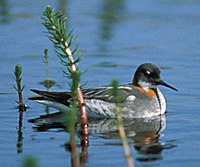
- Baird's Sandpiper, Calidris bairdii
- Pectoral Sandpiper, Calidris melanotos
- Sharp-tailed Sandpiper, Calidris acuminata
- Purple Sandpiper, Calidris maritima
- Rock Sandpiper, Calidris ptilocnemis
- Dunlin, Calidris alpina
- Curlew Sandpiper, Calidris ferruginea
- Stilt Sandpiper, Calidris himantopus
- Spoon-billed Sandpiper, Eurynorhynchus pygmeus (C)
- Broad-billed Sandpiper, Limicola falcinellus (C)
- Buff-breasted Sandpiper, Tryngites subruficollis
- Ruff, Philomachus pugnax
- Short-billed Dowitcher, Limnodromus griseus
- Long-billed Dowitcher, Limnodromus scolopaceus
- Jack Snipe, Lymnocryptes minimus (A)
- Wilson's Snipe, Gallinago delicata
- Common Snipe, Gallinago gallinago
- Pin-tailed Snipe, Gallinago stenura (A)
- Eurasian Woodcock, Scolopax rusticola (C)
- American Woodcock, Scolopax minor
- Wilson's Phalarope, Phalaropus tricolor
- Red-necked Phalarope, Phalaropus lobatus
- Red Phalarope, Phalaropus fulicarius
Pratincoles
Order: Charadriiformes Family: Glareolidae
- Oriental Pratincole, Glareola maldivarum (A)
Skuas, Gulls, Terns, and Skimmers
Order: Charadriiformes Family: Laridae
- Great Skua, Stercorarius skua
- South Polar Skua, Stercorarius maccormicki
- Pomarine Jaeger, Stercorarius pomarinus
- Parasitic Jaeger, Stercorarius parasiticus
- Long-tailed Jaeger, Stercorarius longicaudus
- Laughing Gull, Larus atricilla
- Franklin's Gull, Larus pipixcan
- Little Gull, Larus minutus
A Western Gull in front of the Golden Gate Bridgein San Francisco - Black-headed Gull, Larus ridibundus
- Bonaparte's Gull, Larus philadelphia
- Heermann's Gull, Larus heermanni
- Gray-hooded Gull, Larus cirrocephalus (A)
- Belcher's Gull, Larus belcheri (A)
- Black-tailed Gull, Larus crassirostris (C or A)
- Mew Gull, Larus canus
- Ring-billed Gull, Larus delawarensis
- California Gull, Larus californicus
- Herring Gull, Larus argentatus
- Yellow-legged Gull, Larus cachinnans (C)
- Thayer's Gull, Larus thayeri
- Iceland Gull, Larus glaucoides
- Lesser Black-backed Gull, Larus fuscus
- Slaty-backed Gull, Larus schistisagus
- Yellow-footed Gull, Larus livens
- Western Gull, Larus occidentalis
- Glaucous-winged Gull, Larus glaucescens
- Glaucous Gull, Larus hyperboreus
- Great Black-backed Gull, Larus marinus
- Kelp Gull, Larus dominicanus (C)
- Sabine's Gull, Xema sabini
- Black-legged Kittiwake, Rissa tridactyla
- Red-legged Kittiwake, Rissa brevirostris
- Ross's Gull, Rhodostethia rosea
- Ivory Gull, Pagophila eburnea
- Gull-billed Tern, Sterna nilotica
- Caspian Tern, Sterna caspia
- Royal Tern, Sterna maxima
- Elegant Tern, Sterna elegans
- Sandwich Tern, Sterna sandvicensis
- Roseate Tern, Sterna dougallii
- Common Tern, Sterna hirundo
- Arctic Tern, Sterna paradisaea
- Forster's Tern, Sterna forsteri
- Least Tern, Sterna antillarum
- Aleutian Tern, Sterna aleutica
- Bridled Tern, Sterna anaethetus
- Sooty Tern, Sterna fuscata
- Large-billed Tern, Phaetusa simplex (A)
- White-winged Tern, Chlidonias leucopterus (C or A)
- Whiskered Tern, Chlidonias hybridus (A)
- Black Tern, Chlidonias niger
- Brown Noddy, Anous stolidus
- Black Noddy, Anous minutus
- Black Skimmer, Rynchops niger
Auks, Murres, and Puffins
Order: Charadriiformes Family: Alcidae
- Dovekie, Alle alle
- Common Murre, Uria aalge
- Thick-billed Murre, Uria lomvia
- Razorbill, Alca torda
- Great Auk, Pinguinus impennis (E)
- Black Guillemot, Cepphus grylle
- Pigeon Guillemot, Cepphus columba
- Long-billed Murrelet, Brachyramphus perdix (C)
- Marbled Murrelet, Brachyramphus marmoratus
- Kittlitz's Murrelet, Brachyramphus brevirostris
- Xantus's Murrelet, Synthliboramphus hypoleucus
- Craveri's Murrelet, Synthliboramphus craveri
- Ancient Murrelet, Synthliboramphus antiquus
- Cassin's Auklet, Ptychoramphus aleuticus
- Parakeet Auklet, Aethia psittacula
- Least Auklet, Aethia pusilla
- Whiskered Auklet, Aethia pygmaea
- Crested Auklet, Aethia cristatella
- Rhinoceros Auklet, Cerorhinca monocerata
- Atlantic Puffin, Fratercula arctica
- Horned Puffin, Fratercula corniculata
- Tufted Puffin, Fratercula cirrhata
Pigeons and Doves
Order: Columbiformes Family: Columbidae
- Rock Pigeon, Columba livia (I)
- Scaly-naped Pigeon, Patagioenas squamosa
- White-crowned Pigeon, Patagioenas leucocephala
- Red-billed Pigeon, Patagioenas flavirostris
- Band-tailed Pigeon, Patagioenas fasciata
- Oriental Turtle-Dove, Streptopelia orientalis (A)
- Eurasian Collared-Dove, Streptopelia decaocto (I)
- Spotted Dove, Streptopelia chinensis (I)
- White-winged Dove, Zenaida asiatica
- Zenaida Dove, Zenaida aurita
- Mourning Dove, Zenaida macroura
- Passenger Pigeon, Ectopistes migratorius (E)
- Inca Dove, Columbina inca
- Common Ground-Dove, Columbina passerina
- Ruddy Ground-Dove, Columbina talpacoti
- White-tipped Dove, Leptotila verreauxi
- Key West Quail-Dove, Geotrygon chrysia (C)
- Ruddy Quail-Dove, Geotrygon montana (C)
Lories, Parakeets, Macaws, and Parrots
Order: Psittaciformes Family: Psittacidae
- Budgerigar, Melopsittacus undulatus (I)
- Monk Parakeet, Myiopsitta monachus (I)
- Carolina Parakeet, Conuropsis carolinensis (Extinct)
- Green Parakeet, Aratinga holochlora (I)
- Thick-billed Parrot, Rhynchopsitta pachyrhyncha (I)
- White-winged Parakeet, Brotogeris versicolurus (I)
- Yellow-chevroned Parakeet, Brotogeris chiriri (I)
- Red-crowned Parrot, Amazona viridigenalis (I)
Cuckoos, Roadrunners, and Anis
Order: Cuculiformes Family: Cuculidae
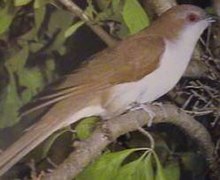
- Common Cuckoo, Cuculus canorus
- Oriental Cuckoo, Cuculus saturatus (C)
- Black-billed Cuckoo, Coccyzus erythropthalmus
- Yellow-billed Cuckoo, Coccyzus americanus
- Mangrove Cuckoo, Coccyzus minor
- Greater Roadrunner, Geococcyx californianus
- Smooth-billed Ani, Crotophaga ani
- Groove-billed Ani, Crotophaga sulcirostris
Barn owls
Order: Strigiformes Family: Tytonidae
- Barn Owl, Tyto alba
Typical owls
Order: Strigiformes Family: Strigidae
- Flammulated Owl, Otus flammeolus
- Oriental Scops-Owl, Otus sunia (A)
- Western Screech-Owl, Megascops kennicottii
- Eastern Screech-Owl, Megascops asio
- Whiskered Screech-Owl, Megascops trichopsis
- Great Horned Owl, Bubo virginianus
- Snowy Owl, Bubo scandiacus
- Northern Hawk Owl, Surnia ulula
- Northern Pygmy Owl, Glaucidium gnoma
- Ferruginous Pygmy-Owl, Glaucidium brasilianum
- Elf Owl, Micrathene whitneyi
- Burrowing Owl, Athene cunicularia
- Mottled Owl, Ciccaba virgata (A)
- Spotted Owl, Strix occidentalis
- Barred Owl, Strix varia
- Great Gray Owl, Strix nebulosa
- Long-eared Owl, Asio otus
- Stygian Owl, Asio stygius (A)
- Short-eared Owl, Asio flammeus
- Boreal Owl, Aegolius funereus
- Northern Saw-whet Owl, Aegolius acadicus
Goatsuckers
Order: Caprimulgiformes Family: Caprimulgidae
- Lesser Nighthawk, Chordeiles acutipennis
- Common Nighthawk, Chordeiles minor
- Antillean Nighthawk, Chordeiles gundlachii
- Common Pauraque, Nyctidromus albicollis
- Common Poorwill, Phalaenoptilus nuttallii
- Chuck-will's-widow, Caprimulgus carolinensis
- Buff-collared Nightjar, Caprimulgus ridgwayi
- Whip-poor-will, Caprimulgus vociferus
- Gray Nightjar, Caprimulgus indicus (A)
Swifts
Order: Apodiformes Family: Apodidae
- Black Swift, Cypseloides niger
- White-collared Swift, Streptoprocne zonaris (A)
- Chimney Swift, Chaetura pelagica
- Vaux's Swift, Chaetura vauxi
- White-throated Needletail Hirundapus caudacutus (C)
- Common Swift, Apus apus (A)
- Fork-tailed Swift, Apus pacificus (C)
- White-throated Swift, Aeronautes saxatalis
- Antillean Palm-Swift, Tachornis phoenicobia (A)
Hummingbirds
Order: Trochiliformes Family: Trochilidae
- Green Violet-ear, Colibri thalassinus
- Green-breasted Mango, Anthracothorax prevostii (A)
- Broad-billed Hummingbird, Cynanthus latirostris
- White-eared Hummingbird, Hylocharis leucotis
- Xantus's Hummingbird, Hylocharis xantusii (A)
- Berylline Hummingbird, Amazilia beryllina (A)
- Buff-bellied Hummingbird, Amazilia yucatanensis
- Cinnamon Hummingbird, Amazilia rutila (A)
- Violet-crowned Hummingbird, Amazilia violiceps (C or A)
- Blue-throated Hummingbird, Lampornis clemenciae
- Magnificent Hummingbird, Eugenes fulgens
- Plain-capped Starthroat, Heliomaster constantii (C)
- Bahama Woodstar, Calliphlox evelynae (C)
- Lucifer Hummingbird, Calothorax lucifer

- Ruby-throated Hummingbird, Archilochus colubris
- Black-chinned Hummingbird, Archilochus alexandri
- Anna's Hummingbird, Calypte anna
- Costa's Hummingbird, Calypte costae
- Calliope Hummingbird, Stellula calliope
- Bumblebee Hummingbird, Atthis heloisa (A)
- Broad-tailed Hummingbird, Selasphorus platycercus
- Rufous Hummingbird, Selasphorus rufus
- Allen's Hummingbird, Selasphorus sasin
Trogons
Order: Trogoniformes Family: Trogonidae
- Elegant Trogon, Trogon elegans
- Eared Quetzal, Euptilotis neoxenus
Hoopoes
Order: Upupiformes Family: Upupidae
- Eurasian Hoopoe, Upupa epops (A)
Kingfishers
Order: Coraciiformes Family: Cerylidae
- Ringed Kingfisher, Megaceryle torquata
- Belted Kingfisher, Megaceryle alcyon
- Green Kingfisher, Chloroceryle americana
Woodpeckers, Sapsuckers, and Flickers
Order: Piciformes Family: Picidae
- Eurasian Wryneck, Jynx torquilla (A)
- Lewis's Woodpecker, Melanerpes lewis
- Red-headed Woodpecker, Melanerpes erythrocephalus
- Acorn Woodpecker, Melanerpes formicivorus
- Gila Woodpecker, Melanerpes uropygialis
- Golden-fronted Woodpecker, Melanerpes aurifrons
- Red-bellied Woodpecker, Melanerpes carolinus
- Williamson's Sapsucker, Sphyrapicus thyroideus
- Yellow-bellied Sapsucker, Sphyrapicus varius
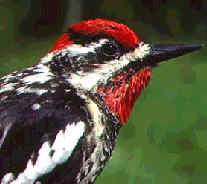
- Red-naped Sapsucker, Sphyrapicus nuchalis
- Red-breasted Sapsucker, Sphyrapicus ruber
- Great Spotted Woodpecker, Dendrocopos major (A)
- Ladder-backed Woodpecker, Picoides scalaris
- Nuttall's Woodpecker, Picoides nuttallii
- Downy Woodpecker, Picoides pubescens
- Hairy Woodpecker, Picoides villosus
- Arizona Woodpecker, Picoides arizonae
- Red-cockaded Woodpecker, Picoides borealis
- White-headed Woodpecker, Picoides albolarvatus
- American Three-toed Woodpecker, Picoides dorsalis
- Black-backed Woodpecker, Picoides arcticus
- Northern Flicker, Colaptes auratus
- Gilded Flicker, Colaptes chrysoides
- Pileated Woodpecker, Dryocopus pileatus
- Ivory-billed Woodpecker, Campephilus principalis
Tyrant flycatchers
Order: Passeriformes Family: Tyrannidae
- Northern Beardless-Tyrannulet, Camptostoma imberbe
- Greenish Elaenia, Myiopagis viridicata (A)
- Caribbean Elaenia, Elaenia martinica
- Tufted Flycatcher, Mitrephanes phaeocercus (A)
- Olive-sided Flycatcher, Contopus cooperi
- Greater Pewee, Contopus pertinax
- Western Wood-Pewee, Contopus sordidulus
- Eastern Wood-Pewee, Contopus virens
- Cuban Pewee, Contopus caribaeus (A)
- Yellow-bellied Flycatcher, Empidonax flaviventris
- Acadian Flycatcher, Empidonax virescens
- Alder Flycatcher, Empidonax alnorum
- Willow Flycatcher, Empidonax traillii
- Least Flycatcher, Empidonax minimus
- Hammond's Flycatcher, Empidonax hammondii
- Gray Flycatcher, Empidonax wrightii
- Dusky Flycatcher, Empidonax oberholseri
- Pacific-slope Flycatcher, Empidonax difficilis
- Cordilleran Flycatcher, Empidonax occidentalis
- Buff-breasted Flycatcher, Empidonax fulvifrons
- Black Phoebe, Sayornis nigricans
- Eastern Phoebe, Sayornis phoebe
- Say's Phoebe, Sayornis saya
- Vermilion Flycatcher, Pyrocephalus rubinus
- Dusky-capped Flycatcher, Myiarchus tuberculifer
- Ash-throated Flycatcher, Myiarchus cinerascens
- Nutting's Flycatcher, Myiarchus nuttingi
- Great Crested Flycatcher, Myiarchus crinitus
- Brown-crested Flycatcher, Myiarchus tyrannulus
- La Sagra's Flycatcher, Myiarchus sagrae (C)
- Great Kiskadee, Pitangus sulphuratus
- Social Flycatcher, Myiozetetes similis (A)
- Sulphur-bellied Flycatcher, Myiodynastes luteiventris
- Piratic Flycatcher, Legatus leucophaius (A)
- Variegated Flycatcher, Empidonomus varius (A)
- Tropical Kingbird, Tyrannus melancholicus
- Couch's Kingbird, Tyrannus couchii
- Cassin's Kingbird, Tyrannus vociferans
- Thick-billed Kingbird, Tyrannus crassirostris
- Western Kingbird, Tyrannus verticalis
- Eastern Kingbird, Tyrannus tyrannus
- Gray Kingbird, Tyrannus dominicensis
- Scissor-tailed Flycatcher, Tyrannus forficatus
- Fork-tailed Flycatcher, Tyrannus savana (C)
- Rose-throated Becard, Pachyramphus aglaiae
- Masked Tityra, Tityra semifasciata (A)
Shrikes

Order: Passeriformes Family: Laniidae
- Brown Shrike, Lanius cristatus (C or A)
- Loggerhead Shrike, Lanius ludovicianus
- Northern Shrike, Lanius excubitor
Vireos
Order: Passeriformes Family: Vireonidae
- White-eyed Vireo, Vireo griseus
- Thick-billed Vireo, Vireo crassirostris (C)
- Bell's Vireo, Vireo bellii
- Black-capped Vireo, Vireo atricapilla
- Gray Vireo, Vireo vicinior
- Yellow-throated Vireo, Vireo flavifrons
- Plumbeous Vireo, Vireo plumbeus
- Cassin's Vireo, Vireo cassinii
- Blue-headed Vireo, Vireo solitarius
- Hutton's Vireo, Vireo huttoni
- Warbling Vireo, Vireo gilvus
- Philadelphia Vireo, Vireo philadelphicus
- Red-eyed Vireo, Vireo olivaceus
- Yellow-green Vireo, Vireo flavoviridis
- Black-whiskered Vireo, Vireo altiloquus
- Yucatan Vireo, Vireo magister
Jays, Crows, Magpies, and Ravens
Order: Passeriformes Family: Corvidae
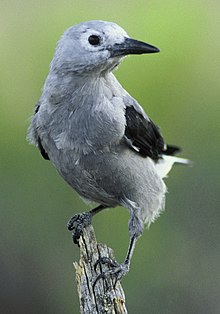
- Gray Jay, Perisoreus canadensis
- Steller's Jay, Cyanocitta stelleri
- Blue Jay, Cyanocitta cristata
- Green Jay, Cyanocorax yncas
- Brown Jay, Cyanocorax morio
- Florida Scrub Jay, Aphelocoma coerulescens
- Island Scrub Jay, Aphelocoma insularis
- Western Scrub Jay, Aphelocoma californica
- Mexican Jay, Aphelocoma ultramarina
- Pinyon Jay, Gymnorhinus cyanocephalus
- Clark's Nutcracker, Nucifraga columbiana
- Black-billed Magpie, Pica hudsonia
- Yellow-billed Magpie, Pica nuttalli
- Eurasian Jackdaw, Corvus monedula (C)
- American Crow, Corvus brachyrhynchos
- Northwestern Crow, Corvus caurinus
- Tamaulipas Crow, Corvus imparatus
- Fish Crow, Corvus ossifragus
- Chihuahuan Raven, Corvus cryptoleucus
- Common Raven, Corvus corax
Larks
Order: Passeriformes Family: Alaudidae
- Sky Lark, Alauda arvensis (regular migrant-AK) (A-CA) (Ex-NY) (I-BC & WA)
- Horned Lark, Eremophila alpestris
Swallows and Martins
Order: Passeriformes Family: Hirundinidae
- Purple Martin, Progne subis
- Cuban Martin, Progne cryptoleuca (A)
- Gray-breasted Martin, Progne chalybea (C)
- Southern Martin, Progne elegans (A)
- Brown-chested Martin, Progne tapera (A)
- Tree Swallow, Tachycineta bicolor
- Mangrove Swallow, Tachycineta albilinea (A)
- Violet-green Swallow, Tachycineta thalassina
- Bahama Swallow, Tachycineta cyaneoviridis
- Northern Rough-winged Swallow, Stelgidopteryx serripennis
- Bank Swallow, Riparia riparia
- Cliff Swallow, Petrochelidon pyrrhonota
- Cave Swallow, Petrochelidon fulva
- Barn Swallow, Hirundo rustica
- House Martin, Delichon urbica (C)
Chickadees and Titmice
Order: Passeriformes Family: Paridae
- Carolina Chickadee, Poecile carolinensis
- Black-capped Chickadee, Poecile atricapilla
- Mountain Chickadee, Poecile gambeli
- Mexican Chickadee, Poecile sclateri
- Chestnut-backed Chickadee, Poecile rufescens
- Boreal Chickadee, Poecile hudsonica
- Gray-headed Chickadee, Poecile cincta
- Bridled Titmouse, Baeolophus wollweberi
- Oak Titmouse, Baeolophus inornatus
- Juniper Titmouse, Baeolophus ridgwayi
- Tufted Titmouse, Baeolophus bicolor
- Black-crested Titmouse, Baeolophus atricristatus
Verdin
Order: Passeriformes Family: Remizidae
- Verdin, Auriparus flaviceps
Bushtits
Order: Passeriformes Family: Aegithalidae
- Bushtit, Psaltriparus minimus
Nuthatches
Order: Passeriformes Family: Sittidae
- Red-breasted Nuthatch, Sitta canadensis
- White-breasted Nuthatch, Sitta carolinensis
- Pygmy Nuthatch, Sitta pygmaea
- Brown-headed Nuthatch, Sitta pusilla
Treecreepers
Order: Passeriformes Family: Certhiidae
- Brown Creeper, Certhia americana
Wrens
Order: Passeriformes Family: Troglodytidae
- Cactus Wren, Campylorhynchus brunneicapillus
- Rock Wren, Salpinctes obsoletus
- Canyon Wren, Catherpes mexicanus
- Carolina Wren, Thryothorus ludovicianus
- Bewick's Wren, Thryomanes bewickii
- House Wren, Troglodytes aedon
- Winter Wren, Troglodytes troglodytes
- Sedge Wren, Cistothorus platensis
- Marsh Wren, Cistothorus palustris
Dippers
Order: Passeriformes Family: Cinclidae
- American Dipper, Cinclus mexicanus
Bulbuls
Order: Passeriformes Family: Pycnonotidae
- Red-whiskered Bulbul Pycnonotus jocosus (I)
Kinglets
Order: Passeriformes Family: Regulidae
- Golden-crowned Kinglet, Regulus satrapa
- Ruby-crowned Kinglet, Regulus calendula
Old World warblers and Gnatcatchers
Order: Passeriformes Family: Sylviidae
- Middendorff's Grasshopper-Warbler, Locustella ochotensis (C)
- Lanceolated Warbler, Locustella lanceolata (A)
- Willow Warbler, Phylloscopus trochilus (A)
- Wood Warbler, Phylloscopus sibilatrix (A)
- Dusky Warbler, Phylloscopus fuscatus (C)
- Yellow-browed Warbler, Phylloscopus inornatus (A)
- Arctic Warbler, Phylloscopus borealis
- Lesser Whitethroat, Sylvia curruca (A)
- Blue-gray Gnatcatcher, Polioptila caerulea
- California Gnatcatcher, Polioptila californica
- Black-tailed Gnatcatcher, Polioptila melanura
- Black-capped Gnatcatcher, Polioptila nigriceps
Old World flycatchers
Order: Passeriformes Family: Muscicapidae
- Narcissus Flycatcher, Ficedula narcissina (A)
- Mugimaki Flycatcher, Ficedula mugimaki (A)
- Red-breasted Flycatcher, Ficedula parva (A)
- Dark-sided Flycatcher, Muscicapa sibirica (C)
- Gray-spotted Flycatcher, Muscicapa griseisticta
- Asian Brown Flycatcher, Muscicapa dauurica (A)
- Spotted Flycatcher, Muscicapa striata (A)

Thrushes
Order: Passeriformes Family: Turdidae
- Siberian Rubythroat, Luscinia calliope
- Bluethroat, Luscinia svecica
- Siberian Blue Robin, Luscinia cyane (A)
- Red-flanked Bluetail, Tarsiger cyanurus (C)
- Northern Wheatear, Oenanthe oenanthe
- Siberian Stonechat, Saxicola maura (C)
- Eastern Bluebird, Sialia sialis
- Western Bluebird, Sialia mexicana
- Mountain Bluebird, Sialia currucoides
- Townsend's Solitaire, Myadestes townsendi
- Orange-billed Nightingale-Thrush, Catharus aurantiirostris (A)
- Black-headed Nightingale-Thrush, Catharus mexicanus (A)
- Veery, Catharus fuscescens
- Gray-cheeked Thrush, Catharus minimus
- Bicknell's Thrush, Catharus bicknelli
- Swainson's Thrush, Catharus ustulatus
- Hermit Thrush, Catharus guttatus
- Wood Thrush, Hylocichla mustelina
- Eurasian Blackbird, Turdus merula (A)
- Eyebrowed Thrush, Turdus obscurus
- Dusky Thrush, Turdus naumanni (C)
- Fieldfare, Turdus pilaris (C or A)
- Redwing, Turdus iliacus (C)
- Clay-colored Robin, Turdus grayi
- White-throated Robin, Turdus assimilis (A)
- Rufous-backed Robin, Turdus rufopalliatus (C)
- American Robin, Turdus migratorius
- Varied Thrush, Ixoreus naevius
- Aztec Thrush, Ridgwayia pinicola (C)
Babblers
Order: Passeriformes Family: Timaliidae
- Wrentit, Chamaea fasciata
Mockingbirds and Thrashers
Order: Passeriformes Family: Mimidae
- Gray Catbird, Dumetella carolinensis
- Black Mockingbird, Melanoptila glabrirostris (A)
- Northern Mockingbird, Mimus polyglottos
- Bahama Mockingbird, Mimus gundlachii
- Sage Thrasher, Oreoscoptes montanus
- Brown Thrasher, Toxostoma rufum
- Long-billed Thrasher, Toxostoma longirostre
- Bendire's Thrasher, Toxostoma bendirei
- Curve-billed Thrasher, Toxostoma curvirostre
- California Thrasher, Toxostoma redivivum
- Crissal Thrasher, Toxostoma crissale
- Le Conte's Thrasher, Toxostoma lecontei
- Blue Mockingbird, Melanotis caerulescens (C)
Starlings
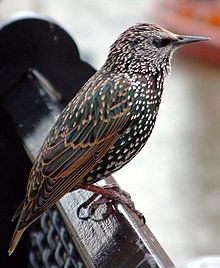
Order: Passeriformes Family: Sturnidae
- European Starling, Sturnus vulgaris (I)
- Common Myna, Acridotheres tristis (I)
- Crested Myna, Acridotheres cristatellus (I & Ex)
Accentors
Order: Passeriformes Family: Prunellidae
- Siberian Accentor, Prunella montanella (C)
Wagtails and Pipits
Order: Passeriformes Family: Motacillidae
- Eastern Yellow Wagtail, Motacilla tschutschensis
- Citrine Wagtail, Motacilla citreola (A)
- Grey Wagtail, Motacilla cinerea (C)
- White Wagtail, Motacilla alba
- Tree Pipit, Anthus trivialis (A)
- Olive-backed Pipit, Anthus hodgsoni (C)
- Pechora Pipit, Anthus gustavi (C)
- Red-throated Pipit, Anthus cervinus
- American Pipit, Anthus rubescens
- Sprague's Pipit, Anthus spragueii
Waxwings
Order: Passeriformes Family: Bombycillidae
- Bohemian Waxwing, Bombycilla garrulus
- Cedar Waxwing, Bombycilla cedrorum
Silky-flycatchers
Order: Passeriformes Family: Ptilogonatidae
- Gray Silky-flycatcher, Ptilogonys cinereus (A)
- Phainopepla, Phainopepla nitens
Olive Warbler
Order: Passeriformes Family: Peucedramidae
- Olive Warbler, Peucedramus taeniatus
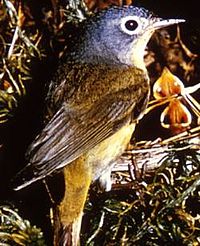
Wood-warblers
Order: Passeriformes Family: Parulidae
- Bachman's Warbler, Vermivora bachmanii (E)
- Blue-winged Warbler, Vermivora pinus
- Golden-winged Warbler, Vermivora chrysoptera
- Tennessee Warbler, Vermivora peregrina
- Orange-crowned Warbler, Vermivora celata
- Nashville Warbler, Vermivora ruficapilla
- Virginia's Warbler, Vermivora virginiae
- Colima Warbler, Vermivora crissalis
- Lucy's Warbler, Vermivora luciae
- Crescent-chested Warbler, Parula superciliosa (C)
- Northern Parula, Parula americana
- Tropical Parula, Parula pitiayumi
- Yellow Warbler, Dendroica petechia
- Chestnut-sided Warbler, Dendroica pensylvanica
- Magnolia Warbler, Dendroica magnolia
- Cape May Warbler, Dendroica tigrina
- Black-throated Blue Warbler, Dendroica caerulescens
- Yellow-rumped Warbler, Dendroica coronata
- Black-throated Gray Warbler, Dendroica nigrescens
- Golden-cheeked Warbler, Dendroica chrysoparia
- Black-throated Green Warbler, Dendroica virens
- Townsend's Warbler, Dendroica townsendi
- Hermit Warbler, Dendroica occidentalis
- Blackburnian Warbler, Dendroica fusca
- Yellow-throated Warbler, Dendroica dominica
- Grace's Warbler, Dendroica graciae
- Pine Warbler, Dendroica pinus
- Kirtland's Warbler, Dendroica kirtlandii
- Prairie Warbler, Dendroica discolor
- Palm Warbler, Dendroica palmarum
- Bay-breasted Warbler, Dendroica castanea
- Blackpoll Warbler, Dendroica striata
- Cerulean Warbler, Dendroica cerulea
- Black-and-white Warbler, Mniotilta varia
- American Redstart, Setophaga ruticilla
- Prothonotary Warbler, Protonotaria citrea
- Worm-eating Warbler, Helmitheros vermivorus
- Swainson's Warbler, Limnothlypis swainsonii
- Ovenbird, Seiurus aurocapilla
- Northern Waterthrush, Seiurus noveboracensis
- Louisiana Waterthrush, Seiurus motacilla
- Kentucky Warbler, Oporornis formosus
- Connecticut Warbler, Oporornis agilis
- Mourning Warbler, Oporornis philadelphia
- MacGillivray's Warbler, Oporornis tolmiei
- Common Yellowthroat, Geothlypis trichas
- Gray-crowned Yellowthroat, Geothlypis poliocephala
- Hooded Warbler, Wilsonia citrina
- Wilson's Warbler, Wilsonia pusilla
- Canada Warbler, Wilsonia canadensis
- Red-faced Warbler, Cardellina rubrifrons
- Painted Redstart, Myioborus pictus
- Slate-throated Redstart, Myioborus miniatus (A)
- Fan-tailed Warbler, Euthlypis lachrymosa (C or A)
- Golden-crowned Warbler, Basileuterus culicivorus (C)
- Rufous-capped Warbler, Basileuterus rufifrons
- Yellow-breasted Chat, Icteria virens
Bananaquits
Order: Passeriformes Family: Coerebidae
- Bananaquit, Coereba flaveola
Tanagers
Order: Passeriformes Family: Thraupidae
- Hepatic Tanager, Piranga flava
- Summer Tanager, Piranga rubra
- Scarlet Tanager, Piranga olivacea
- Western Tanager, Piranga ludoviciana
- Flame-colored Tanager, Piranga bidentata
- Western Spindalis, Spindalis zena
American sparrows, Towhees, Juncos, and Longspurs
Order: Passeriformes Family: Emberizidae
- White-collared Seedeater, Sporophila torqueola
- Yellow-faced Grassquit, Tiaris olivacea (A)
- Black-faced Grassquit, Tiaris bicolor (C)
- Olive Sparrow, Arremonops rufivirgatus
- Green-tailed Towhee, Pipilo chlorurus
- Spotted Towhee, Pipilo maculatus

- Eastern Towhee, Pipilo erythrophthalmus
- Canyon Towhee, Pipilo fuscus
- California Towhee, Pipilo crissalis
- Abert's Towhee, Pipilo aberti
- Rufous-winged Sparrow, Aimophila carpalis
- Cassin's Sparrow, Aimophila cassinii
- Bachman's Sparrow, Aimophila aestivalis
- Botteri's Sparrow, Aimophila botterii
- Rufous-crowned Sparrow, Aimophila ruficeps
- Five-striped Sparrow, Aimophila quinquestriata
- American Tree Sparrow, Spizella arborea
- Chipping Sparrow, Spizella passerina
- Clay-colored Sparrow, Spizella pallida
- Brewer's Sparrow, Spizella breweri
- Field Sparrow, Spizella pusilla
- Worthen's Sparrow, Spizella wortheni (A)
- Black-chinned Sparrow, Spizella atrogularis
- Vesper Sparrow, Pooecetes gramineus
- Lark Sparrow, Chondestes grammacus
- Black-throated Sparrow, Amphispiza bilineata
- Sage Sparrow, Amphispiza belli
- Lark Bunting, Calamospiza melanocorys
- Savannah Sparrow, Passerculus sandwichensis
- Grasshopper Sparrow, Ammodramus savannarum
- Baird's Sparrow, Ammodramus bairdii
- Henslow's Sparrow, Ammodramus henslowii
- Le Conte's Sparrow, Ammodramus leconteii
- Nelson's Sharp-tailed Sparrow, Ammodramus nelsoni
- Saltmarsh Sharp-tailed Sparrow, Ammodramus caudacutus
- Seaside Sparrow, Ammodramus maritimus
- Fox Sparrow, Passerella iliaca
- Song Sparrow, Melospiza melodia
- Lincoln's Sparrow, Melospiza lincolnii
- Swamp Sparrow, Melospiza georgiana
- White-throated Sparrow, Zonotrichia albicollis
- Harris's Sparrow, Zonotrichia querula
- White-crowned Sparrow, Zonotrichia leucophrys
- Golden-crowned Sparrow, Zonotrichia atricapilla
- Dark-eyed Junco, Junco hyemalis
- Yellow-eyed Junco, Junco phaeonotus
- McCown's Longspur, Calcarius mccownii
- Lapland Longspur, Calcarius lapponicus
- Smith's Longspur, Calcarius pictus
- Chestnut-collared Longspur, Calcarius ornatus
- Pine Bunting, Emberiza leucocephalos (A)
- Little Bunting, Emberiza pusilla (A)
- Rustic Bunting, Emberiza rustica
- Yellow-throated Bunting, Emberiza elegans (A)
- Yellow-breasted Bunting, Emberiza aureola (A)
- Gray Bunting, Emberiza variabilis (A)
- Pallas's Bunting, Emberiza pallasi (A)
- Reed Bunting, Emberiza schoeniclus (C)
- Snow Bunting, Plectrophenax nivalis
- McKay's Bunting, Plectrophenax hyperboreus
Cardinals, Saltators, and Grosbeaks
Order: Passeriformes Family: Cardinalidae
- Crimson-collared Grosbeak, Rhodothraupis celaeno (C)
- Northern Cardinal, Cardinalis cardinalis
- Pyrrhuloxia, Cardinalis sinuatus
- Yellow Grosbeak, Pheucticus chrysopeplus (C)
- Rose-breasted Grosbeak, Pheucticus ludovicianus
- Black-headed Grosbeak, Pheucticus melanocephalus
- Blue Bunting, Cyanocompsa parellina (C)
- Blue Grosbeak, Passerina caerulea
- Lazuli Bunting, Passerina amoena
- Indigo Bunting, Passerina cyanea
- Varied Bunting, Passerina versicolor
- Painted Bunting, Passerina ciris
- Dickcissel, Spiza americana
Blackbirds, Meadowlarks, Cowbirds, Grackles, and Orioles
Order: Passeriformes Family: Icteridae
- Bobolink, Dolichonyx oryzivorus
- Red-winged Blackbird, Agelaius phoeniceus
- Tricolored Blackbird, Agelaius tricolor
- Tawny-shouldered Blackbird, Agelaius humeralis (C)
- Eastern Meadowlark, Sturnella magna
- Western Meadowlark, Sturnella neglecta
- Yellow-headed Blackbird, Xanthocephalus xanthocephalus
- Rusty Blackbird, Euphagus carolinus
- Brewer's Blackbird, Euphagus cyanocephalus
- Common Grackle, Quiscalus quiscula
- Boat-tailed Grackle, Quiscalus major
- Great-tailed Grackle, Quiscalus mexicanus
- Shiny Cowbird, Molothrus bonariensis
- Bronzed Cowbird, Molothrus aeneus
- Brown-headed Cowbird, Molothrus ater
- Black-vented Oriole, Icterus wagleri (A)
- Orchard Oriole, Icterus spurius

- Hooded Oriole, Icterus cucullatus
- Streak-backed Oriole, Icterus pustulatus (C)
- Bullock's Oriole, Icterus bullockii
- Spot-breasted Oriole, Icterus pectoralis (I)
- Altamira Oriole, Icterus gularis
- Audubon's Oriole, Icterus graduacauda
- Baltimore Oriole, Icterus galbula
- Scott's Oriole, Icterus parisorum
Fringilline Finches, Cardueline Finches, and Allies
Order: Passeriformes Family: Fringillidae

- Common Chaffinch, Fringilla coelebs (C)
- Brambling, Fringilla montifringilla
- Gray-crowned Rosy-Finch, Leucosticte tephrocotis
- Black Rosy-Finch, Leucosticte atrata
- Brown-capped Rosy-Finch, Leucosticte australis
- Pine Grosbeak, Pinicola enucleator
- Common Rosefinch, Carpodacus erythrinus
- Purple Finch, Carpodacus purpureus
- Cassin's Finch, Carpodacus cassinii
- House Finch, Carpodacus mexicanus
- Red Crossbill, Loxia curvirostra
- White-winged Crossbill, Loxia leucoptera
- Common Redpoll, Carduelis flammea
- Hoary Redpoll, Carduelis hornemanni
- Eurasian Siskin, Carduelis spinus (A)
- Pine Siskin, Carduelis pinus
- Lesser Goldfinch, Carduelis psaltria
- Lawrence's Goldfinch, Carduelis lawrencei
- American Goldfinch, Carduelis tristis
- Oriental Greenfinch, Carduelis sinica (C)
- Eurasian Bullfinch, Pyrrhula pyrrhula (C)
- Evening Grosbeak, Coccothraustes vespertinus
- Hawfinch, Coccothraustes coccothraustes (C)
Old World sparrows
Order: Passeriformes Family: Passeridae
- House Sparrow, Passer domesticus (I)
- Eurasian Tree Sparrow, Passer montanus (I)
Weavers

Order: Passeriformes Family: Ploceidae
- Orange Bishop, Euplectes franciscanus (I)
- Java Sparrow, Padda oryzivora (I & Ex)
See also
- List of birds
- List of regional bird lists
- List of birds of Santa Cruz County, California
- List of Florida birds
- List of Kansas birds
- List of Minnesota birds
- List of Missouri birds
- List of Oklahoma birds
References
- The A.O.U. Check-list of North American birds, seventh edition - the official source on the taxonomy of birds found in North and Middle America. Captured May 27, 2005.
- ABA Checklist Accessed February 26, 2006.


